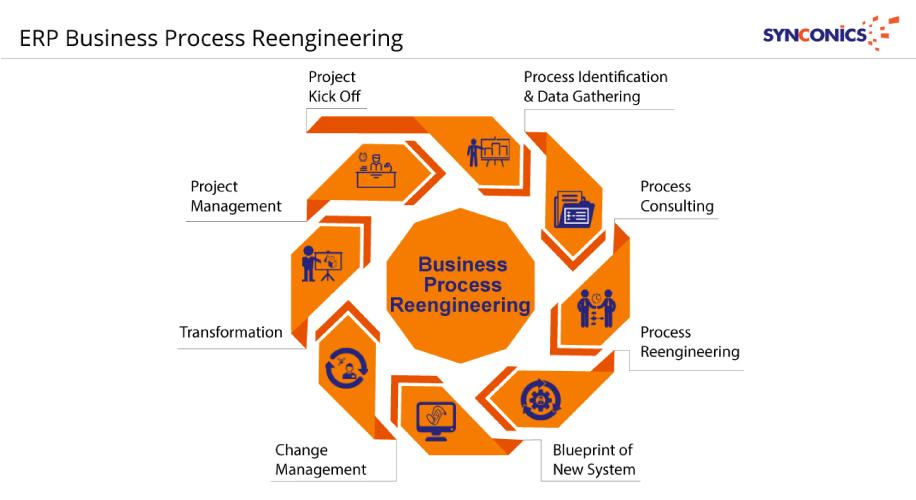BPR (Business Process Reengineering)
BPR (Business Process Reengineering) involves the examination and redesign of business processes and workflows in your organization. Move from serial operations to concurrent operations. In other words, multitask instead of just doing one thing at a time.
Processes, organization, structure and information technologies are the key components of BPR, which automates business processes across the enterprise and provides an organization with a well-designed and well-managed information system. Enterprise Resource Planning (ERP) and Business Process Re-engineering (BPR) evolved almost at the same time, both are having the primary intend to optimize workflow and improve productivity.
BPR Method transforms an organization in ways that directly affect the performance. BPR, if implemented correctly, can give higher ROIs. BPR is about the proper reengineering method of implementation within a company for better returns. A successful BPR implementation brings significant improvement to productivity, customer service and bottom-line. There are pain and difficulties during implementation and instances where BPR efforts did not achieve desired result.
BPR Cycle: Plan, Discover, Analyze, Re-Model and Implement are the five steps of BPR. BPR implementation completes in three phase; first phase-process consulting, second phase-change management, and third phase- project management.

BPR (Business Process Reengineering) Phases:
Project kick off: Project goal, project team and communication standards are agreed upon. A number of workshops are held where project scope, sponsors commitment, project risk, milestones and deliverables are discussed. Strength, Weakness, Opportunities and Threat analysis is carried out with active participation of all.
Process identification and data gathering: “As is” processes are assembled through flow charts. Current practice of Interfacing with business partners is gathered. Bottlenecks, delays, complexity, internal blame games, idle assets etc. are brought forward. Use of existing technologies is comprehended. Major and strategic business processes to be reengineered, are identified. Stakeholders categorize the processes to be reengineered and agreed upon on the timeline of implementation.
Process consulting: BPR consultants define objectives, finalize scope, select procedures, process champion, kickoff meeting. After this they gather information from various departments, map the current process, study IT capability, and identify metrics and process issues. In the next step they analyze process issue, do GAP analysis and recommend solutions. Then they re-design processes, define metrics, define implementation road map and develop business case. In the last step they implement solution and monitor metrics, refine targets and free tune the process.
Process Reengineering: In this phase, actual reengineering begins. A number of brain storming sessions are held with project team and other stakeholders, where current business processes are critically analyzed to determine non value adding activities and identify excess control and check, always with customer value as a focal point. Impact of new technologies on process improvement is also evaluated. New process ideas with reduced check and control and enabling technologies such as Workflow automation and ERP, are envisaged. Benchmarking is also done with best of breed industrial peers.
Blueprint of new system: Blueprinting involves modelling workflow and information requirement, of new business processes. “To be” processes are modelled using various modelling tools. New organization structures, human resource need, performance monitoring and compensation, technological needs, are also outlined. Normally, a first cut redesign scheme is produced which is modified after gathering actionable feedback from the stakeholders.
Change management: BPR consultants finalize the team, prepare project, perform risk analysis and develop project plan in the planning step. In the next steps they focus on project oversight, client relationship, status report, learning review and project closure.
Transformation: A migration strategy and a migration plan is the first step of transformation. Migration strategy may decide as a pilot, phases or big bang implementation. The migration plan would include establishment of new organizational structure, detailed training and reallocation of workforce, and cut off dates for implementation. Change management and introduction of new technologies will form an important part and may need engagement of outside consultants for this specific purpose. There should be provision on the plan to tweak the implemented system so as to get maximum value out of it.
Project management: BPR consultants plan awareness campaign, top management workshop, communication workshop. They change profile characteristics, change readiness assessment, change management plan and implement change management plan.
Business Process Reengineering or Enterprise Resource Planning: For successful of BPR implementation, Information Technology plays the role of a key enabler. Therefore, a question is raised whether it is logical to directly implement ERP and re-engineer business processes by adopting world class practices, contained in ERP packages. This approach would avoid embarking on BPR which is expensive, time consuming and often risky. Also reengineered process arising out of BPR exercise may not be best of class. On the other hand, there is a grave risk in this approach if a proper ERP package is not chosen. Process orientation and ownership will be lacking from employees which may lead to major implementation difficulties.
Ready to supercharge your Businesses.
Jump-start your implementation and drive ROI by collaborating with industry experts, consultants, and support engineers throughout your journey.
Our highly trained representative are standing by, ready to help.
|
|